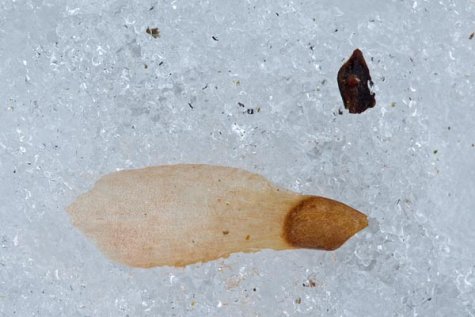Spruces spill seeds
Photo: Arne Ader
Translation: Liis
Spruce seed on snow
Norway spruce; European spruce; Common spruce Harilik kuusk Picea abies
A spruce seed is less than half a centimetre long, dark brown, egg-shaped with a pointed tip. The seed is borne on the air flows by a yellowish shiny wing that is slightly more than a centimetre long.
From the spruce seed growing forests the cones have been collected, now nature does its own sowing; we haven’t had a decent spruce cone year for the past six years. The spruce spreads in forests mainly by the winged seeds.
The spruces that grow in Estonia have highly variable characteristics; many ramblers in forests have noted it. Scientists distinguish up to 130 subspecies, varieties and forms. Of course the differently shaped candelabra and snake spruces attract most attention, but we notice differences even in the colour of the bark. Our climate suits spruces. In the age of manors seeds were brought in from Germany, during the occupation years from all sorts of localities in Russia and from Finland; all this shows.
As for soil, spruces prefer a fertile soil similar to that in hardwood forests. Spruces shrivel in water-logged soil and do not develop in very dry soils. As forest floor plants they develop slowly, but as high-growing species they later take over from other species. If our forests were to develop without human interference, spruces would rule in a couple of hundred years in most of Estonia.









